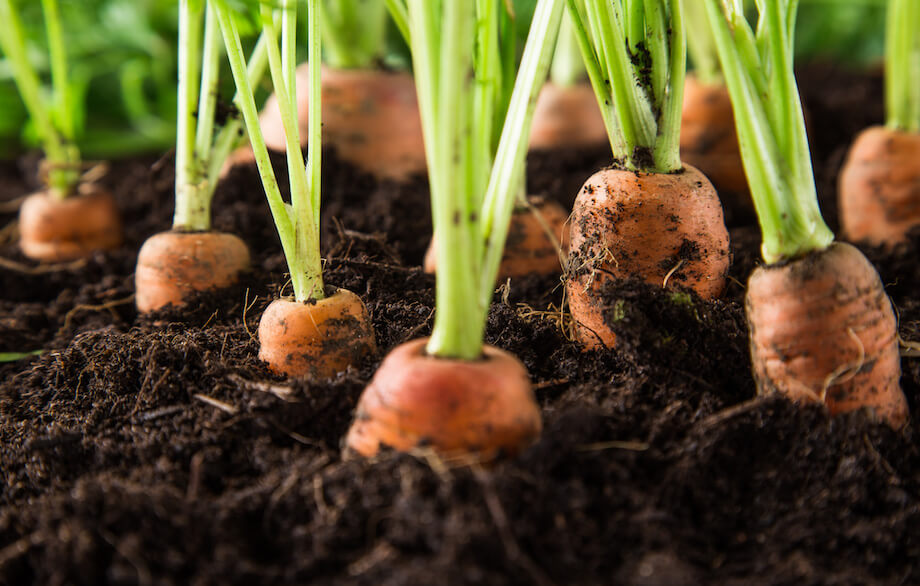Tomatoes are a staple of the American diet. You can grow many varieties of tomatoes—pick the ones that make the most sense for your garden based on your preferred texture, appearance, and flavor.
You can grow dozens of different varieties from miniature grape tomatoes to heirloom. Traditional favorites cultivated in homestead gardens include:
- Early Girl Tomato
- Big Beef Tomato
- Celebrity Tomato
- Big Boy Tomato
- Grape or Cherry Tomatoes
- Jersey Tomato
In the U.S., you can grow tomatoes outdoors in US Plant Hardiness Zones 4 through 7.
What Is Companion Garden Planting?
Experienced gardeners have known for years that companion planting produces the juiciest, plumpest, and most flavorful tomatoes. Companion planting is an age-old method of combining vegetables that grow best when planted grouped together in the garden. Companion planting benefits one or both plants planted near each other. When carefully selected, companion plants:
- Enhance flavor
- Deter harmful insects and damaging plant diseases
- Improve plant health and vigor
- Maximize gardening space
Companion Planting Produces Healthier Plants And An Abundant Harvests
For centuries, savvy gardeners have known that mixed plantings offer improved insect control over a monoculture in which plants of the same type are planted together, row after row.
Companion Planting Controls Insect Infestation
The practice of planting certain fruits and vegetables next to each other repels insects and controls plant diseases that can inhibit garden growth. Several plants, especially pungent herbs such as rosemary, thyme, sage, basil, and borage act as repellents, deterring insect infestation by masking the scent of the intended host plant or emitting an odor noxious to invasive insect pests and other unwelcome garden “critters.” The scent of basil is especially beneficial to the garden, confusing insects and masking the scent of the garden plants you wish to protect from insect infestation.
Companion Planting Maximizes Garden Space
Radishes, lettuce, and other fast-growing garden plants sown between hills of potatoes, melons, winter squash or rows of tomatoes will reach maturity and be harvested long before vine-like plants require more “wiggle-room” to grow. Planting leaf lettuce (or other low-growing greens) around or near tomato plants provides a “living mulch” that helps trap vital moisture in the soil.
That being said, let’s discuss the different companion plants for tomatoes.
Best Companions For Tomato Plants
Calendula

Add beauty and color to the garden plot by planting Calendula, also known as pot marigold. Not to be confused with the common summer annual, Calendula is an excellent companion plant that repels insects. The flowers and tender young leaves of Calendula are edible and make a colorful and tasty addition to salads, soups, and stews. Plants in the marigold family repel root knot nematodes and white flies.
Carrots

Plant carrots adjacent or surrounding the area you allot to your tomato plants. Plant carrots early in the spring, before the tomatoes. This gives the carrots a chance to become established before they have to compete for nutrients with tomatoes or other late spring garden plantings. In mid-to-late summer, do a second planting of carrots, after tomatoes have matured, to provide a winter supply of the tasty root vegetable.
Other Good Neighbors For Tomatoes
“Good Neighbor” plants work in support of each other. Other garden herbs and vegetables useful in companion plantings with tomatoes include:
- Hyssop
- Mint
- Chives
- Gooseberries
- Beets
- Brussels Sprouts
- Cauliflower
- Celery
How To Grow Tomatoes In A Japanese Tomato Ring
To grow a seemingly endless supply of sweet, succulent tomatoes all summer long, consider a time-tested method designed to encourage a bumper tomato harvest. Construct a Japanese-style tomato ring in a sunny spot in the garden.

Preparing The Bed
First, prep a circular bed in a sunny, well-drained location. The circle should be about 6- to 10-feet in diameter. Prepare the soil by forking over the soil while adding equal parts of peat moss and organic compost.
Experienced gardeners suggest well-aged herbivore manure (sheep, horse, goat, or cow) or aged garden compost. Work the organic materials well into the soil. Break up dirt clods and work all the elements together until the soil is damp, coarse and mealy.
Planting An Inner Circle Companion Plant
In the center of the circle, plant rosemary, which flourishes in rich garden compost. Rosemary enhances the flavor of tomatoes and wards off a diverse array of garden pests including spiders, mites, and aphids.
Building The Ring
Wearing protective leather garden gloves, wrap 10-12 feet of cattle or chicken wire into a tall column or cylinder. Stand the cylinder centered in the heart of the tomato bed, encasing the rosemary planting.
Form a mound around the base of the column for stability from alternating layers of the soil mixture, dried grass, and leaves. Water well. The soil should be moist, but not soggy.
Planting The Tomatoes
Plant 4-6 tomato plants around the base of the cylinder: spacing 18-24 inches apart. As the tomato plants grow, anchor them to the cylinder for support.
Planting Outer Circle Companion Plants
In an outer circle, about one foot from around the base of your tomatoes, plant green beans and nasturtiums, alternating seeds as you proceed to plant around the circle.
As they mature, train the bean and nasturtium vines to climb the column or cylinder. Nasturtiums add lively color to the garden, and the flowers and leaves are delicious.
Add nasturtium flowers and leaves to salads and stews or use the brilliant yellow, orange and red flowers as a plate garnish. Nasturtiums repel insects, especially aphids and will help keep your tomato plants vigorous and healthy.
If space allows, plant basil near your tomato plants. Basil repels spider mites, aphids, hornworms, and whiteflies while attracting bees to improve tomato plant pollination.
How To Keep Tomato Plants Healthy
Watering Tomatoes
Water the center of the compost frequently. The roots of the plants will grab the nutrient-rich food and water to produce a stellar crop.
Remove Leaves To Limit Disease
Trim off lower leaves, below the fruiting branches on your tomato plants, to keep disease away. The disease originates from leaves close to the soil which trap moisture.
Keeping lower leaves trimmed will significantly diminish the chance of losing your harvest. Planting low-growing creeping thyme (Thymus vulgaris) around the base of tomato plants also helps foil disease by repelling insect carriers, and adds to the flavor of the tomato crop.
Use An Old Farmer’s Trick To Keep Birds Away
If birds feast on your tomatoes, deceive them with an old farmer’s trick. Tie a few bright red holiday ornaments to the support cylinder before the tomato plants flower.
Birds will think the ornaments are tomatoes. Birds peck at the decoration only to find no fruit or flavor. The birds won’t return when your tomatoes are ripe.
Avoid Over-Fertilizing Your Tomatoes
Do not over-fertilize your tomatoes. The compost will provide everything they need. Too much fertilizer encourages a flood of nitrogen that produces dense, dark green foliage but few tomatoes. Wait until the plants start to fruit, then add a generous dollop of aged manure to the compost pile, watering well.
Dill, planted near your tomato plants will repel hornworms and also enhances tomato flavor.
Add A Little Light As Tomato Plants Mature
Like peppers, tomatoes require radiant heat to produce large, firm and flavorful fruits. Ripen tomatoes by covering the ground beneath the plants with reflective aluminum foil sheeting or tack a few sheets on a nearby fence to provide additional light during the maturation process.
Make Tomato Plants Stronger With Milk
The tobacco mosaic virus can rapidly destroy a promising tomato crop. Prevent an infestation by swishing out milk containers and pouring the liquid on your tomato plants. Don’t drink enough milk to do the job? A simple solution of a tablespoon of powdered milk in a quart of water will do the trick.
Water tomato plants with a milky solution once a week during the entire growing season. Milky water will also protect cabbage plants from cabbageworm.
The Key To Successful Companion Planting
Observe and record the plant combination you plant from year to year, making a note of the results of your efforts. The Old Farmer’s Almanac notes, “Sometimes plants may be helpful to one another only at a certain stage of their growth. The number and ratio of different plants growing together are often a factor in their compatibility, and sometimes plants make good companions for no apparent reason.”
Amazing Health Benefits Of Tomatoes
Tomatoes are a treasure trove of important nutrients. The deep red color of tomatoes is a fine source of lycopene, a non-pro-vitamin A antioxidant rich carotenoid pigment associated with bone and cardiovascular health. Tomatoes are also an excellent source of vitamin C, molybdenum, vitamin K, biotin, manganese, potassium, vitamin A, vitamin B6, vitamin E, phosphorus, copper, potassium, and dietary fiber.
Tomato Planting References
- Home Gardening, The United States Department Of Agriculture
- An Update on the Health Effects of Tomato Lycopene, US National Library Of Medicine – National Institute Of Health
- US Plant Hardiness Zone Map, United States Department Of Agriculture










































I’ve been growing tomatoes for over 15 years organically, so it was nice to see a new suggestion for supporting tomato vines; I’m looking forward to trying that Japanese tomato ring. I’ve been having more problems lately with worms, so I’m going to add basil & calendula this next crop. We had a very wet September through November this year, so the lack of high heat explains the poor flavor & size of my crop. Thanks for the good suggestions!